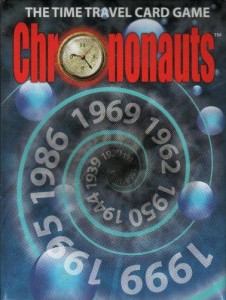 You don’t have to be a history buff to stop and wonder what the world would look like if events in the past worked out differently then they had. What would the world look like if the US never entered World War 2? How would the course of America look if Kennedy was never assassinated? Well now you can find out!
You don’t have to be a history buff to stop and wonder what the world would look like if events in the past worked out differently then they had. What would the world look like if the US never entered World War 2? How would the course of America look if Kennedy was never assassinated? Well now you can find out!
Chrononauts is the time traveling card game from the creative minds at Looney Labs. Players must travel around the timeline adjusting significant events in history to try and make their own, personal time line a reality. Is Chrononauts worth the time it takes to play or should it be banished to history? Read on to find out.
Chrononauts is a time traveling card game for 1-6 players that plays in about 30 minutes. The game is best played with up to 2-4 people.
Game Overview:
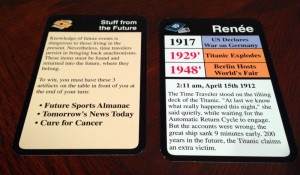
In Chrononauts, you are a time traveler with an important job. You must keep continuity alive by repairing paradoxes (more on that later) that are caused by other travels messing with history. Each player gets a unique identity, a secret mission and a hand of cards. Using an easy draw 1, play 1 mechanic, players will adjust the historical events on the timeline and try to collect artifacts along the way. The first one to achieve one of the games 3 victory conditions is the winner.
Game Components:
Being a card game, the game components are about what you’d expect: A box of cards. The cards are the usual stock for a card game and the art feels somewhat more functional than pretty. The gadgets and artifacts have some creative artwork, but for the most part, you aren’t going to be amazed by the artwork. But that’s ok, because some of the text on the cards more than makes up that. Chrononauts does a great job of keeping the game play light with its comical phrasing on the cards. For example, one of the patch cards has the quote: “The Mild Recession ‘Things could be much worse’ asserts FDR”. One of the alternate timeline cards says: “Titanic Avoids Iceberg ‘We almost hit that’ says lookout.” It’s jokes like that that keep me coming back to Chrononauts again and again.
How to Play:
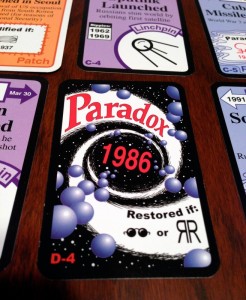
The game play of Chrononauts is very simple to pick up. First, each player starts with a unique identity card. This card will have 3 specific time points in history that a player must make the timeline match to win. A player will also receive a mission card. This will involve players trying to collect specific artifacts from history. After each player has their ID card and mission, the timeline is laid out in an 8×4 grid on the table. The first player takes their turn and play proceeds clockwise around the table until someone wins.
On a players turn they must:
1. Draw one card.
2. Play one card. A player may play any card from their hand or, if they don’t’ want to play one, discard a card. If they choose to discard, they may also discard a second card and draw a new one to replace it (called wasting time in the game).
As far as what types of cards you are playing on your turn, there are a number of different options:
• Artifacts: Collect these to win
• Gadgets: Give you special powers to use
• Actions/Timewarps: Single use action cards
• Inverters: Here is where the game gets interesting. Each card in the timeline is either a linchpin or a ripple point. Inverters can flip over any linchpin card. When they do, the alternate history on the back of the linchpin card becomes the new reality. Linchpins will also flip any of it’s ripple point cards when it goes. For example, if The Manhattan Project never happened in 1943, then an Atom Bomb would never be dropped n Japan in 1945 and the Cuban Missile Crisis will never happen in 1962. Both of those 2 timeline cards would be flipped, but the back of them is not an alternate history but a paradox. Paradoxes are bad. They are so bad, in fact, that if the timeline ever has 13 of them everyone loses the game. So what’s an intrepid time traveler to do? Well that brings us to the last card type:
• Patches: These get played on any paradox. You not only fix the paradox but you can possibly get yourself closer to winning the game if the patch matches the one on your ID card. Patches are an alternate reality for the timeline. For example, if the Cuban Missile Crisis never happened, the new alternate realty is World War 3 happens. All of human civilization is wiped out. Darn.
Patching the paradoxes is so good that if you do, you can draw an extra card. That’s very good because it gets you closer to the 3rd win condition (yes, there are 3 ways to win).
Play continues around in the draw 1, play 1 fashion until someone wins the game. The three ways to win are:
1. Have the timeline match your ID card. Usually this involves one linchpin and 2 patches.
2. Collect all the artifacts on your mission. This will take some luck as you basically just have to try and draw them from the draw deck (or steal them from another player).
3. Have ten cards in your hand. Hard to do, but possible if you patch a lot.

Game Experience:
The hardest part about playing Chrononauts is getting people to understand the relationship between the linchpins and the ripple points. It’s a little confusing at first, but once you run through a few examples, they shouldn’t have any problems. It helps that everything is color coded. Linchpins are purple when they match today’s reality and red when they hit the alternate timeline. Ripple points are all blue until they are fliped to a paradox. The gadgets and action cards also do a good job of explaining on the card exactly what they do. I think after a few people have played inverters, everyone should get the feel for how to play the game.
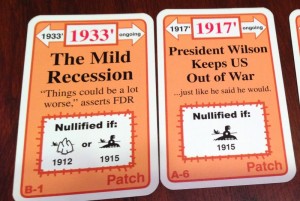
And that’s one thing I really like about Chrononauts. The game is a lot of fun and it also takes a light hearted approach to history. The jokes on the cards can be incredibly entertaining. Going back in time to find Carl Sagan’s joint or a very bad Mona Lisa forgery is pretty entertaining. The game does deal with some sensitive topics (Waco Texas, WW2 Final Solution), but in no way is offensive. This is our world’s history, like it or not.
My favorite part of the game is probably just playing with the timeline. I like flipping some of the bigger linchpins to just see what havoc I can wreck with the timeline. There is even a World War 3 patch that can be played in 1962 (over the Cuban Missle Crisis). When that happens, everything post 1962 is destroyed (inaccessible) until that patch is removed due to the world ending.
Speaking of removing patches, that’s one of the easiest ways to mess with your opponents. Other than stealing their artifacts (stole by a clever “get there first card”), there isn’t too much direct interaction with your opponents. The main way will be undoing their timeline changes. You can do this by restoring any linchpin they have inverted. They don’t want Pearl Harbor to be Bombed by the Japanese so they flip it and all its ripple points? Too bad, you can flip it right back over and undo all their hard work. This can be especially frustrating if they have applied some patches to the ripple points. Those patches will all get dumped to the discard pile if the paradox is flipped back to its original side.
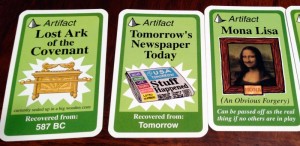
If you can’t tell by now, there is going to be a health dose of luck in this game. This probably shouldn’t come as a surprise anyway, since most card games are somewhat luck based. This comes into play with the artifact win condition more than anything. If you don’t get your artifact off your random draw, you have to hope your opponent does and that you can steal it. You can also have your well laid plans destroyed by your opponents meddling with the timeline (as described above). For players who hate luck in games, this will probably annoy them. But for the rest of us, it’s never been enough of an issue in Chrononauts that would turn me away. In my experience, most games are won by a player completing their identity card. Occasionally it will happen on accident as someone just plays a patch for the heck of it.
If you can handle the luck and some of the crazy randomness, then you will probably enjoy the hell out of Chrononauts. The writing on the cards can be very humorous, it’s fun to meddle in the history of our planet and the game plays pretty smoothly. With players usually only have around 3 cards in their hand, turns should continue to go by pretty quickly. That’s a great thing when you are looking for a quick card game to pass the time.
Final Thoughts:
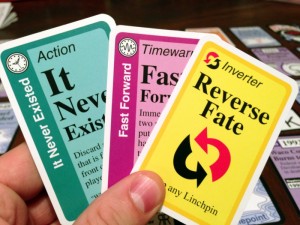
In my opinion, Chrononauts is far and away the best game ever produced by Looney Labs. I wish they would come out with another expansion to take us through the current year as the game ends at 1999. I’d love to see their take with some of the more modern history. They do have a “Gore Years” expansion that takes the game to 2008, but it’s only an 11 card addition.
But regardless of its age (Chrononauts was produced in 2000), Chrononauts still makes many trips to my gaming table. We always seem to have a great time playing around with history and the easy to learn rules and inviting theme make it perfectly accessible to your non-gamer friends. It also helps that the game is very portable and can easily make trips with us by being tossed in a bag.
That being said, Chrononauts isn’t the deepest game around. I’d probably put it a notch above your standard filler games. It has some strategy and planning required, but also healthy dose of card drawing luck. As a meaty filler game, you’d be hard pressed to find better.
There aren’t many time travel games out there for some reason, but Chrononauts is probably one of my favorites. It’s easy to learn, plays quickly, very portable and really inexpensive. Give Chrononauts a try today, it should find a welcome home in your gaming collection. Just try not to start World War 3.
If you are interested in getting a copy for yourself, it’s about $15
Final Score: 3 Stars – A fun card game that has a great theme and is on the meatier side of the filler game category.
 Hits:
Hits:
• Easy to learn game play
• Entertaining card text
• Engaging and fun theme
• Quick play time
Misses:
• Hard to achieve some victory conditions
• Explaining the linchpin/ripple point mechanic takes some work





















Our family has home rules for Chrononauts. Each time you flip a linchpin, you must explain how you physically alter the timeline. When you invert that linchpin back to its original state, you must explain how you undo the first player’s historical meddling. And so on… This usually devolves into a complicated series of assassinations and anti-assassinations at the 1936 Olympics (where you can murder Hitler and stop WWII).
As huge nerds and roleplay fans, this small addition elevates the simple game to one of our family’s favorites.
That’s a great idea! We are always big fans of making our games a bit more thematic.